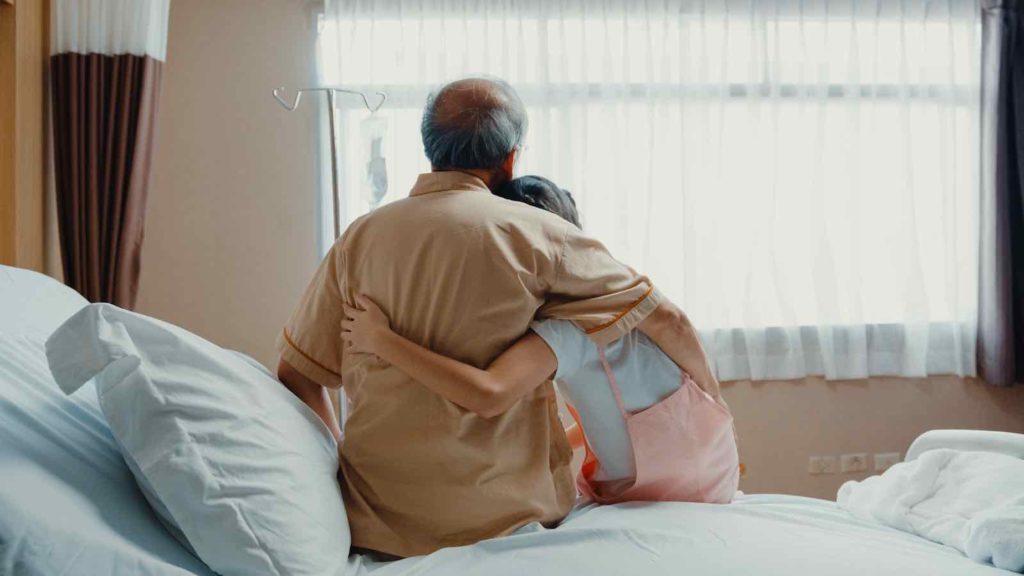There are a lot of myths and misconceptions about hospice care. With so much conflicting information out there, it can be hard to know what to expect when considering this type of care for a loved one. Our clients know that they can come to their hospice team with questions and receive research-based and compassionate answers.
Our team is here to dispel hospice myths and help our clients stay informed and up-to-date on the realities of today’s hospice care.

Myth: The patient’s family is not made a priority.
Contrary to common belief, hospice care does not leave the family playing catch-up. Family members are encouraged to be a part of the process as they are able to, and are considered valuable members of the care team. Additionally, the family’s team of nurses, counselors, social workers, chaplains, and more are assigned according to their specific needs and desires. Hospice care can take place in the patient’s home or in the home of a family member. Family members are kindly and practically guided through each step of the process, and their opinions and questions are welcomed.
Hospice care services aren’t just provided to the patient, either. Family members and loved ones can also receive support regarding the process, paperwork, and concerns, as well as emotional assistance. Instead of placing the burden of medical treatment and case management on the family, our team provides assistance to the family while providing top-notch care to their loved one.
Myth: Hospice care is out-of-hospital palliative care.
Hospice is not a specific location, but an ideology of care. Hospice can take place in a facility, or in a beloved sunroom, bedroom, or living room. It can look like a loved one surrounded by family. It can also look like a family patriarch bonding with a minister through great conversation and laughter.
Dispelling hospice myths includes discussing the idea that it is the same as palliative care. The ideology of hospice care stems from research and patient comfort, as does palliative care. However, palliative care may take place in a hospital and be utilized by patients still seeking curative treatment. Meanwhile, hospice is more commonly intended for end-of-life care, better suited for patients seeking comfort and stability over a cure or treatment.
Patients who choose hospice care commonly see increased physical comfort, decreased stress, and improved mental and spiritual wellbeing. Wherever the hospice care takes place, patients tend to feel more relaxed and empowered to make their own decisions while including family in their plan of care. Hobbies and everyday routines are still available and encouraged to patients, as they often continue to live at home while receiving care.
Testimonials like the one below reflect the relief and comfort experienced by many families who choose hospice care:
“We have used a number of nursing services for my mother. I was at my wits end… a medical assistant at a doctor’s office recommended Envision Hospice because, while my mother was still in fair health, because of her diagnosis, she was eligible for services. The nurses and nursing assistant were great…”
Let’s continue dispelling hospice myths by addressing one of the most common ones.

Myth: Receiving hospice care means giving up on life.
Understandably, many people who come to us have concerns that their loved one has “given up” on living. Television’s portrayal of hospice care often makes it look like a death bed. This simply isn’t true. Patients who choose hospice care are looking for care that focuses on higher quality of life, comfort, and control.
Receiving hospice care does not hasten death, and it does not mean the patient is totally reliant on a caregiver. Comfort is key in hospice care, and many patients end up living several months longer than they would’ve if they were in a hospital. A specialized team meets their individual needs, and the patient continues to have options throughout the process. Patients are not required to sign “Do Not Resuscitate” forms, and they are given clear guidance on end-of-life documentation. Hospice care doesn’t end after the patient passes away, either. The family members of the patient can continue to receive the support they need.
Myth: Hospice care is expensive or unattainable.
As we are dispelling hospice myths, let’s discuss this common concern. Contrary to popular belief, hospice care is attainable and affordable for many families and patients. Many people are skeptical about choosing hospice care due to the expected costs. However, Medicare and most insurance companies provide hospice care as a benefit. Additionally, support can be provided to families through financial advising and case management.
Some families worry that a long waitlist or stack of paperwork stands between their loved one and their care. This is not the case with Envision Hospice. Our team is available 24/7 to talk about your options or to answer any questions you have. Attentive, specialized care is just a phone call (and yes, a few signatures) away. A kindhearted team is accessible to guide patients through each step of the process. You never need to face this alone.
To view more practical information about hospice care, check out our Frequently Asked Questions page. If you’d like to start a conversation about hospice care for your loved one, or have questions about hospice care in general, please contact us here anytime. Our team is waiting to hear from you with kind and attentive care.

